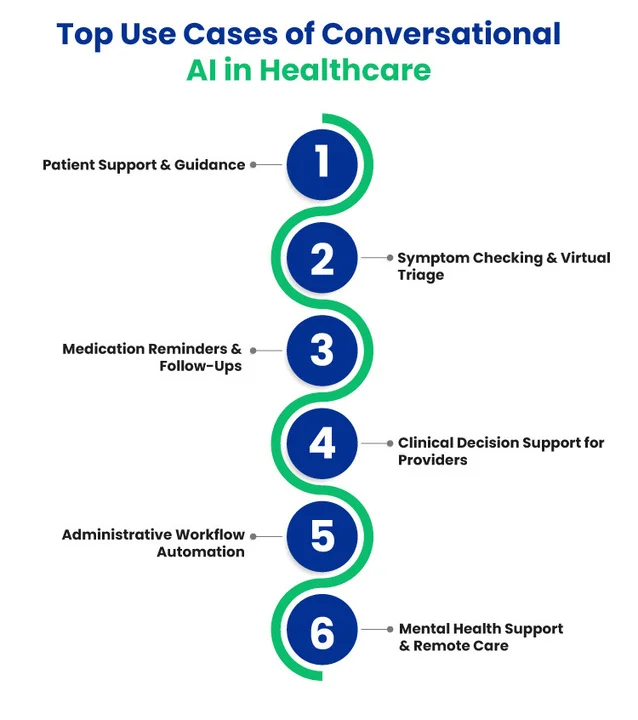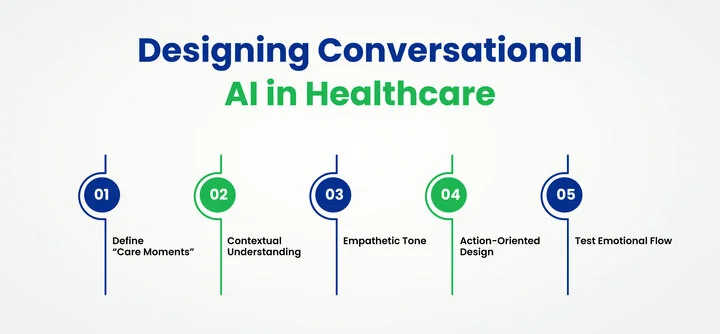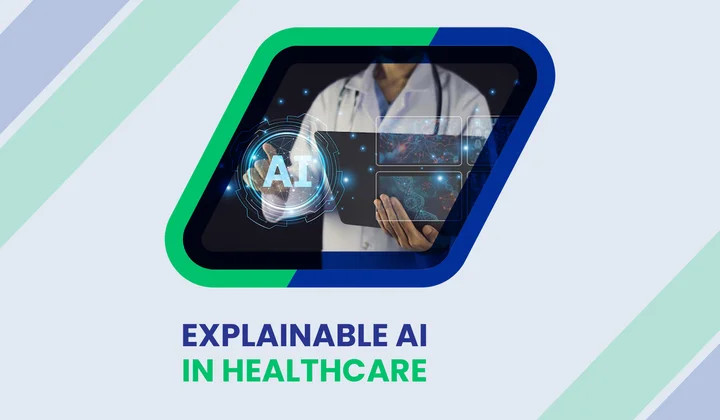Healthcare conversations are changing fast. What once took hours on the phone or days of waiting now happens in minutes, sometimes even seconds.
That’s the impact of conversational AI in healthcare, a technology that’s helping patients get answers faster and allowing doctors to focus on care rather than paperwork.
Did you know?
The conversational AI market in healthcare was valued at $13.53 billion in 2024 and is expected to reach $48.87 billion by 2030. This rapid growth points out the importance of AI-driven conversations in modern healthcare systems.
However, healthcare conversational AI is making care more connected, accessible, and patient-focused. It improves healthcare solutions and makes assistance always available when needed, but it does not replace human care.
In this blog, we’ll explore where conversational AI in healthcare is making the biggest difference, how the most significant improvements are being made to deliver empathy and accuracy, and what healthcare teams must consider for compliance and data security.
Alright, let’s start it!
What Is Conversational AI in Healthcare?
Many healthcare providers are adopting conversational AI to make patient communication more natural and efficient. This technology enables real-time interaction via text or voice, making it easier for patients and healthcare professionals to exchange information quickly and accurately.
Such solutions are developed with the help of Healthcare Software Development specialists who ensure the systems are secure, reliable, and patient-focused.
Table of Contents
Additionally, Conversational AI in healthcare refers to intelligent digital systems capable of understanding, processing, and responding to human language. They can handle multiple queries at once, saving valuable time for patients and staff.
To understand how it works, consider its main components:
- Natural Language Processing (NLP): Understands meaning and tone.
- Machine Learning (ML): Learns from past conversations.
- Speech Recognition: Converts spoken language into text.
- Context Awareness: Provides relevant, personalized answers.
Furthermore, conversational AI differs from traditional chatbots. Regular chatbots follow fixed scripts, while conversational AI adapts to the situation and offers responses that sound more human.
Build secure, compliant AI assistants that help healthcare teams cut admin work by up to 40% and improve patient response times.
Now that the concept of conversational AI in healthcare is clear, the following section discusses its most impactful use cases across the industry.
How Are Conversational AI Use Cases Changing Healthcare?
Conversational AI is slowly becoming the helping hand healthcare teams didn’t know they needed. It’s used in hospitals, clinics, and even wellness apps that are powered by custom software development services that simplify and speed up patient communication.
Instead of waiting on hold or filling out endless forms, patients can now get real-time answers, schedule appointments, and receive follow-ups through AI-driven chats and voice tools.
Now let’s look at some real use cases where conversational AI is making healthcare more supportive and connected for both patients and providers.

1. Patient Support and Guidance
Let’s start with one of the most relatable uses of conversational AI in healthcare patient support. These tools make healthcare communication faster and more approachable by helping users:
- Ask questions about symptoms or conditions.
- Find the right specialists.
- Book appointments without long waiting times
They also make a big difference for people who prefer private and reliable conversations over phone calls. Instead of waiting on hold, patients can simply chat with an AI assistant anytime they need help.
For example, Ada Health and Babylon Health offer chat-based AI platforms that guide users through their health concerns step by step. It feels like having a calm, knowledgeable assistant ready whenever you need clarity, and improving patient engagement with conversational chatbots.
2. Symptom Checking and Virtual Triage
Next comes another vital use case. Before visiting a doctor, patients can describe what they’re feeling, and the AI helps them determine the level of care they might need.
This approach:
- Saves time for both patients and medical staff
- Reduces unnecessary hospital visits
- Makes the initial care process less stressful
A great example is the Mayo Clinic’s AI-powered symptom checker, which helps users identify possible conditions and suggests whether to seek urgent care or manage symptoms at home. It brings a sense of calm to uncertain moments, offering guidance when patients need it most.
3. Medication Reminders and Patient Follow-Ups
It can be challenging to remember to take prescription drugs on time, particularly for people with chronic illnesses. That’s where AI-powered reminders and follow-ups come in.
These tools help by:
- Sending medication alerts
- Tracking adherence
- Offering gentle encouragement to stay consistent
For instance, Medisafe reminds users when to take their medicine and shares helpful details, such as potential interactions and timing tips. It’s like having a supportive health companion making sure you never miss a dose.
4. Clinical Decision Support for Providers
Conversational AI in healthcare helps physicians and providers make better, quicker decisions. Providers can ask virtual assistants for patient insights or evidence-based recommendations rather than manually searching records or reports.
With tools like IBM Watson Assistant for Health, clinicians can:
- Review patient histories quickly
- Access treatment guidelines instantly
- Identify potential risks or next steps
This helps reduce administrative pressure and ensures medical professionals can spend more time doing what matters most for their patients.
5. Administrative Workflow Automation
Behind every healthcare service is a lot of paperwork and scheduling. AI-driven automation helps lighten that load by taking care of repetitive tasks like:
- Appointment booking and confirmations
- Insurance verification
- Answering common patient queries
For example, Northwell Health fuses conversational AI to handle patient registration and scheduling.
The result?
Patients are happier, wait times are shorter, and fewer appointments are missed, all while employees concentrate on higher-value tasks.
6. Mental Health Support and Remote Care
Finally, one of the most compassionate applications of conversational AI is in mental health care. These tools create a safe space for people to open up, reflect, and find emotional support anytime they need it.
Apps like Wysa and Woebot offer AI-driven conversations that use cognitive behavioral therapy (CBT) techniques to:
- Helps users manage stress and anxiety
- Encourage healthier thinking habits.
- Provide round-the-clock emotional support.
They don’t replace therapists but serve as comforting companions that help bridge the gap between therapy sessions or moments of need.
As more organizations invest in mental health software development services, conversational AI is becoming an essential part of accessible and continuous emotional support systems worldwide.
How Can Conversational AI in Healthcare Be Designed Effectively?
Behind every helpful healthcare chatbot is a thoughtful design process. Every response, question, and tone choice is carefully built to make conversations feel real, reliable, and compassionate.
However, good design makes the difference between a patient feeling frustrated and one feeling cared for. To ensure every interaction fosters comfort, understanding, and trust, healthcare teams pay attention to both the AI’s words and its delivery.
Developing AI that truly understands patient needs requires guidance from Healthcare Software Development specialists who are experienced in building secure, patient-focused systems.
The following elements define the design of conversational AI healthcare systems, built to deliver both accuracy and empathy.

1. Defining the “Care Moment”
Before any wireframe or dataset is built, designers map out what moments of care the chatbot should support, such as pre-appointment anxiety, symptom confusion, or medication reminders.
For example, Mayo Clinic’s virtual assistant was built around a simple care moment: helping people decide whether they should see a doctor. That clarity shaped everything from tone to workflow, making the chatbot feel calm, direct, and trustworthy.
This approach ensures that the design aligns with real emotional and practical needs, not just technical goals.
2. Building Medical Understanding with Context
Accuracy is essential, but context makes it meaningful. Not only can a good healthcare AI identify symptoms, but it also comprehends how people define them.
If a user types “my chest feels tight after jogging,” a well-designed system knows this isn’t necessarily the same as “I have chest pain right now.” That contextual intelligence reduces panic and prevents misinformation.
Developers often pair clinical datasets with natural language inputs gathered from honest patient conversations to make the AI’s understanding more human.
3. Designing Conversations That Build Trust
In healthcare, tone is everything. Patients often reach out when they’re anxious or uncertain, and a cold, robotic tone can easily break trust.
That’s why designers use “microcopy empathy”: it is a minor, thoughtful language tweak that makes conversations sound warm and supportive.
For example:
- Instead of “Invalid input,” the AI might say, “I’m sorry, I didn’t quite catch that. Could you tell me a bit more?”
- Instead of “Appointment not found,” it might say, “Looks like I couldn’t find your appointment, so do you want me to check again?”
These subtle choices make the chatbot feel emotionally intelligent rather than mechanical.
4. Designing for Action, Not Just Chat
The most effective healthcare AIs accomplish tasks rather than merely talking. The system should direct users toward important outcomes, whether that means sharing lab results, reminding users to take their medications, or scheduling appointments.
For instance, the Cleveland Clinic’s chatbot can pull patient data directly from its EHR system to confirm upcoming visits or check insurance coverage. This seamless action design turns a basic conversation into a productive healthcare experience.
5. Testing with Real Emotions in Mind
Most teams test for accuracy, and the great ones test for emotional flow. They ask real patients to interact with the chatbot and describe how it made them feel.
Did it sound reassuring? Was it patient enough? Did it reduce confusion?
This kind of testing brings authenticity. For example, during Wysa’s beta phase, users’ emotional feedback directly influenced the AI’s response to distress, leading to a softer tone during high-stress inputs.
How Can Healthcare Ensure Conversational AI Compliance and Data Security?
Thoughtful design helps conversational AI sound empathetic, but compliance makes it dependable. Since these systems handle personal health details, every interaction must be built around patient safety, privacy, and trust.
This is ensured through QA and testing services that keep every process secure and compliant. Without solid data governance, even the most advanced chatbot could risk sensitive information and patient confidence.
Here’s how healthcare organizations can ensure conversational AI compliance in healthcare while protecting data integrity.

1. Meeting HIPAA and GDPR Requirements
Privacy laws form the foundation of regulatory requirements for AI in healthcare.
- HIPAA (Health Insurance Portability and Accountability Act) in the U.S. ensures that all patient data shared digitally, from appointment reminders to chat-based consultations, is encrypted and stored securely.
- GDPR (General Data Protection Regulation) in the EU gives users control over their data, requiring organizations to obtain explicit consent and to allow data deletion upon request.
For healthcare AI platforms, compliance means building security into every workflow: encrypting data transfers, limiting who can access stored chats, and keeping audit trails for transparency.
2. Handling PHI (Protected Health Information) Responsibly
Protected Health Information (PHI) includes anything that could identify a patient, including their test results and appointment history. Conversational AI systems must treat this data as highly confidential.
To achieve that:
- Use end-to-end encryption during all conversations.
- Store data in HIPAA-compliant cloud environments with restricted access.
- Train and test AI models only with de-identified or synthetic datasets.
For example, many healthcare technology vendors now use anonymized simulation data to refine their AI systems, ensuring that real patient identities are never exposed during development or testing.
3. Model Transparency, Explainability, and Bias Mitigation
Transparency in healthcare AI is essential for trust. Users and clinicians should be able to understand how an AI system interprets input, prioritizes responses, or makes recommendations.
To promote this, teams can:
- Publish clear documentation about model behavior.
- Offer explanations for how conclusions are reached (explainable AI).
- Audit datasets regularly to remove bias or outdated medical information.
For instance, a well-governed conversational AI might flag when its confidence in a medical response is low, prompting a referral to a human clinician rather than offering uncertain guidance.
4. Governance and Ethical Use of AI in Healthcare
Strong AI governance ensures compliance is an ongoing commitment. Many healthcare organizations are now forming AI oversight committees that define policies around data use, accountability, and risk management.
Ethical frameworks often include:
- Regular reviews of AI decision accuracy
- Policies for consent, retention, and data deletion
- Protocols for escalating sensitive or high-risk interactions to human staff
Setting clear rules allows healthcare teams to ensure that every AI-powered exchange adheres to medical ethics, patient dignity, and organizational integrity.
5. Strengthening Patient Trust Through Security
Ultimately, compliance and transparency lead to one outcome: trust. Patients are far more likely to engage with digital assistants when they feel their data is private, respected, and handled ethically.
When healthcare providers combine design empathy with strong security and governance, conversational AI becomes more than a convenience. It becomes a trusted part of patient care.
Frequently Asked Questions (FAQs)
2. What are the Best Practices for Designing Conversational AI for Hospitals?
When designing conversational AI for hospitals, focus on:
- Using a warm, human-like tone that builds trust
- Ensuring context awareness for accurate responses
- Guiding users toward clear actions (bookings, reports, etc.)
- Testing with real patients for emotional flow and usability
- Maintaining compliance and data security from the start
3. How Can Healthcare Chatbots Ensure HIPAA Compliance?
To meet HIPAA standards, healthcare chatbots must protect all patient data they handle. This includes using end-to-end encryption, storing information in secure, HIPAA-compliant environments, and limiting access to chat records. Additionally, chatbots should only collect necessary data and be transparent about how it’s used, which helps maintain both privacy and patient trust.
4. Can Conversational AI be Integrated with EHR Systems?
Yes, many healthcare organizations are now integrating conversational AI with Electronic Health Record (EHR) systems. This allows AI assistants to securely pull patient data, confirm appointments, and share lab results in real time. When done correctly, it reduces staff workload and makes patient interactions smoother, without compromising security or compliance.
Final Takeaway: The Future of Conversational AI in Healthcare
As healthcare becomes more digital, conversational AI is emerging as more than just a helpful tool; it’s becoming a bridge between patients and providers. In addition to altering the way care is provided, it is also altering how it feels, from symptom checks to emotional support.
But while the benefits are clear, scaling these systems responsibly is where most healthcare teams struggle. Questions around compliance, patient data protection, and integration often hold innovation back.
This is where partnering with a trusted AI consulting service can make a difference by helping organizations design AI solutions that are secure, compliant, and built around real healthcare needs.
As we look ahead, conversational AI will continue to grow, blending empathy with intelligence. The organizations that focus on ethical design, transparency, and patient trust today will lead the way in shaping a more connected and compassionate healthcare future.
Integrate secure conversational tools into your healthcare system to improve care delivery, reduce admin work, and stay patient-focused.








Share your thoughts about this blog!